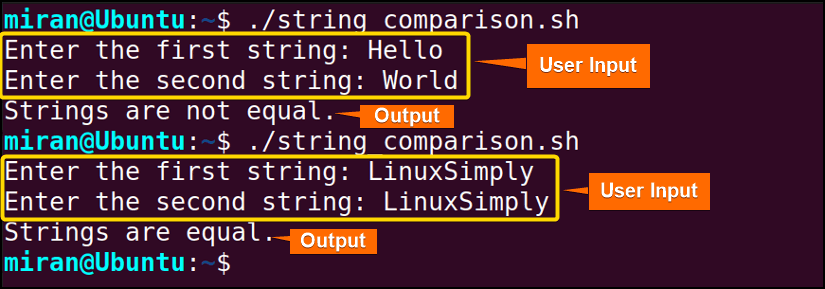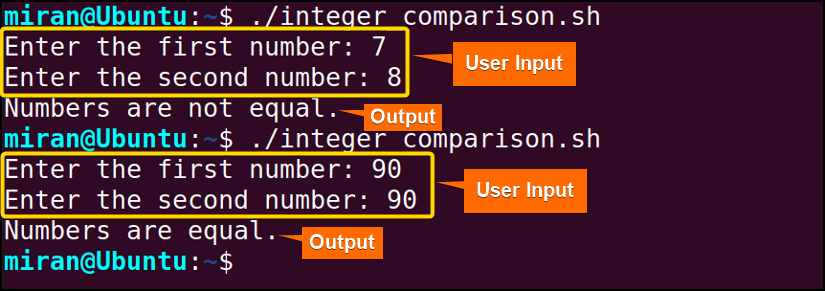FUNDAMENTALS A Complete Guide for Beginners

The “!“ (NOT) operator in Bash scripting is a logical operator used to invert the exit status of a command. It’s valuable for conditionals and error checking. In this article, I will demonstrate 3 different examples of using the NOT operator in bash scripting. So let’s start.
NOT Operator in Shell Script
In shell scripting, the NOT operator is represented by the exclamation mark (!). It is used to negate a condition or logical expression. When you place the NOT operator before a condition, it flips the condition’s truth value. For example, ! true becomes false, and ! false becomes true. The NOT operator is commonly used in conditional statements to reverse the logic and perform actions when a condition is not met. It’s a fundamental tool for making decisions and creating complex logic in shell scripts.
Syntax of the NOT Operator in Bash Script
In Bash, the basic syntax of NOT Operator is as follows:
if [ ! condition ]; then
# Code to execute if the condition is not true
fi
Or,
if [[ ! condition ]]; then
# Code to execute if the condition is not true
fi
Or,
if ! test condition; then
command1
command2
fi
In each syntax, the exclamatory sign (!) flips the output value of the conditions such that it returns true if the condition gives false and false if the conditional exit status is true.
4 Practical Examples of Using the NOT Operator in Bash Scripts
Given below, there are 4 practical examples that I have articulated for your perusal. The example will articulate the effective way of string and integer comparison. Further, you will learn how to check whether a variable is empty or not using the NOT operator. Lastly, you will learn the way to negate the IF conditional. Don’t forget to run those codes in your command line.
1. Using NOT Operator for String Comparison in Bash
In my first code, the objective is to allow a user to input two strings and then compare them to determine whether they are equal or not. Check and follow the steps given below and replicate the same in your terminal.
To use the NOT operator for string comparison, use the script mentioned below:
#!/bin/bash
#taking the input value from the user
read -p "Enter the first string: " str1
read -p "Enter the second string: " str2
#checking whether the given strings are equal or not
if [ "$str1" != "$str2" ]; then
echo "Strings are not equal."
else
echo "Strings are equal."
fi
The provided Bash script facilitates a user-driven comparison of two inputted strings. It begins by prompting the user to enter the first string, storing this input in the variable str1. Subsequently, it instructs the user to input the second string, saving it in str2.
Then the script employs the != operator within an if statement to evaluate whether str1 is dissimilar to str2. If the condition proves true, indicating inequality between the two strings, the script outputs “Strings are not equal.” Conversely, if the condition is false, signifying that the strings are identical, it outputs “Strings are equal.”

2. Inserting NOT Operator for Integer Comparison in Bash
Following the previous code, I want to enable users to input two numerical values and compare them to determine if they are equal or not. To accomplish the task, I will use the NOT operator in a bash script.
To compare integer numbers using the NOT operator, follow the script below:
#!/bin/bash
read -p "Enter the first number: " number1
read -p "Enter the second number: " number2
if [ ! "$number1" -eq "$number2" ]; then
echo "Numbers are not equal."
else
echo "Numbers are equal."
fi
The given bash code prompts users to enter the values, stores them in variables, and then employs the -eq operator within an if statement. If the numbers are not equal, as indicated by the ! operator before the condition, the script outputs “Numbers are not equal.” Conversely, if the numbers are equal, it displays “Numbers are equal” by using the echo command.
 As you can understand from the image given above, the code can successfully identify the equality of two given integers and return the corresponding response to the command line.
As you can understand from the image given above, the code can successfully identify the equality of two given integers and return the corresponding response to the command line.
3. Checking the Variable Whether Empty Using NOT Operator in Bash
In this code, the objective is to allow a user to define a variable and then determine whether the provided variable is empty or not. To do so, I will incorporate a NOT operator to accomplish the task.
To check if a variable is empty or not using the NOT operator, use the script given below:
#!/bin/bash
read -p "Enter a value: " userVar
if [ ! -z "$userVar" ]; then
echo "The variable is not empty."
else
echo "The variable is empty."
fi
This Bash script is designed to assess whether a user-inputted variable, denoted as userVar, is empty or not. It begins by using the read command along with a prompt to collect user input, which is stored in userVar. Subsequently, it employs an if statement to evaluate the condition [ ! -z “$userVar” ], wherein the not operator ! is used in combination with the -z flag to check if userVar is not empty. If the condition holds true, the script prints “The variable is not empty.” Conversely, if the condition is false, indicating that the variable is empty, it outputs “The variable is empty.”

4. Negate the IF condition in a Bash Script Using the ! (NOT) Operator
From the script given below, you will learn how to negate if condition using the ! NOT operator in a bash script with two different approaches. One is incorporating! sign inside the double square bracket and the other is keeping the sign outside of the double square bracket.
When the NOT operator resides outside the double square brackets [[, it will run the expression(s) enclosed within the brackets and invert the outcome. That means, If you have multiple expressions, then the entire result will be negated. On the other hand, If you put NOT Operator inside the double square, then the operator will be applied only to the individual expression.
To negate a IF condition using a NOT operator, use the following script:
#!/bin/bash
# Assign a value to the 'num' variable
read -p "Give me the first number to be evaluated: " num1
# Check if 'num1' is not equal to 0
if ! [[ $num1 -eq 0 ]]
then
# If the condition is true, print a message
echo "Value of first number is not 0"
fi
read -p "Insert the second number: " num2
# Check if 'num2' is not equal to 0
if [[ ! $num2 -eq 0 ]]
then
# If the condition is true, print a message
echo "Value of the second number is not 0 either"
fi
The given bash code utilizes the ! (NOT) operator outside of the -eq (equal) operator and double square brackets [[ … ]]. Subsequently, the user has a prompt to enter the first number, storing it in the num1 variable, and checking if num1 is not equal to 0. If this condition is met, the script prints the message “Value of the first number is not 0.”
In the second part of the code, it uses the ! operator with the -eq operator also within double square brackets and is applied when the user is prompted to input the second number, which is stored in the num2 variable. The script then checks if num2 is not equal to 0 using this method, and if the condition holds true, it displays the message “Value of the second number is not 0 either”.

Conclusion
In Bash scripting, the NOT operator effectively reverses the truth value of a condition or expression. By placing the NOT operator before a statement, one can transform true into false and false into true. In this article, I have demonstrated an overview of the NOT operator in bash. However, if you have any questions or queries related to this article, feel free to comment below. Thank you.
People Also Ask
What does != Mean in shell script?
In a shell script, “!=” means “not equal to.” It’s used in conditional statements to compare two values and check if they are not the same.
What is an example of a not operator?
In shell scripting, the NOT operator, represented as “!“, is used to negate a condition. For instance, “if ! -f file.txt” checks if “file.txt” does not exist, enabling you to take specific actions when a particular condition is not met, and adding flexibility to your scripts.
Is the NOT operator a binary operator?
The NOT operator (!) is a unary operator in shell scripting, acting on a single operand to negate its logical value. It reverses true to false and false to true, making it a fundamental tool for creating conditional statements and handling logical expressions in scripts.
What is the not in binary code?
In binary code, the not operation is represented as a bitwise NOT operator, usually denoted as “~.” It flips each bit, turning 0 into 1 and 1 into 0.
Related Articles
- Boolean Variables “True False” and Logical Operators in Bash
- Usage of Logical “AND (&&)” Operator in Bash Scripting
- Usage of “OR” Operator in Bash Scripting [2 Cases]
<< Go Back to Bash Logical Operators | Bash Operator | Bash Scripting Tutorial



